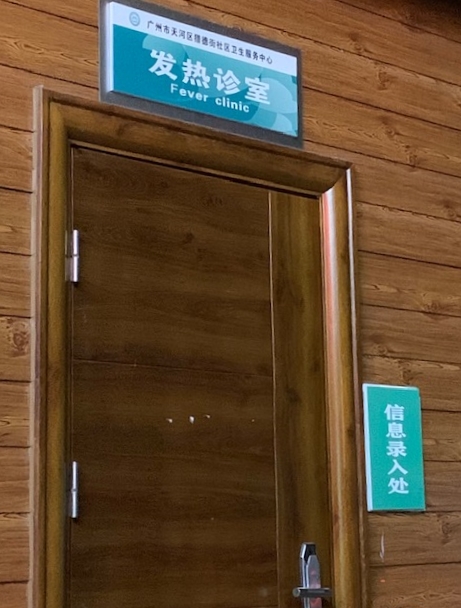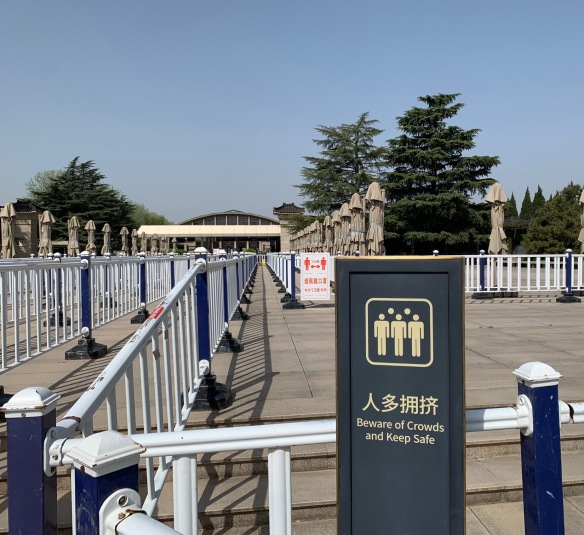Having left whinging about travel stress behind me, I am now free to wax lyrical on the wonders of Xi’an, which are myriad.
This was my second trip, to catch all I missed last time. I booked with a group tour because in China, guides make everything a thousand percent easier. Also, a food tour group means you can try more. I simply cannot consume 10 dishes per meal as a solo traveler!
Still, the independent traveler spirit hasn’t been completely beaten out of me. I added an extra day and a half on my own to check out additional sights like the Tomb of Emperor Jingdi and the Wild Goose Pagodas. After all, I figured, it’s not like I’m going to make a THIRD trip back to Xi’an. I should check everything off the list!
Jingdi’s Tomb, aka the Yangling Mausoleum, is the 141 BCE burial place of a Han Dynasty emperor. He was buried with over 50,000 terracotta figurines, representing daily life of the day. In one part of the site you can see the burial pits with figurines in situ; in another there are fully unearthed figurines displayed in a museum setting.
Anywhere else in the world this would be the premiere tourist sight of the region. Sadly for Jingdi, he’s competing with another emperor and another set of terracotta figurines (see below).
Next up, the Wild Goose Pagodas, two of Xi’an’s most famous landmarks. Both were built to hold Buddhist treasures brought to China from India.
The Small Wild Goose Pagoda was being cleaned when I visited so I couldn’t climb to the top. Who even wants to climb a building dating from 707 that lost a couple of meters’ height during a 1556 earthquake?
I kind of did.
Fortunately the Giant Wild Goose Pagoda was open for business. This one dates from 649 and also has a history of instability. The exterior collapsed and was rebuilt in 704 by the Empress Wu Zeitan, who doubled the number of stories from five to ten. Then in that pesky 1556 earthquake, three stories came down. I climbed the remaining seven. This pagoda is in the middle of the Daci’en Temple complex, worth a visit even if climbing towers of questionable structural integrity isn’t your thing.
At this point in my journey it was time to meet up with my tour guide and co-travelers for our first group activity, an evening food tour of the Muslim quarter. Was I assuming this would be a repeat of the food tour I’d done on my first visit to Xi’an? Yes. Did I care? No sir! I probably would have been upset if we hadn’t gone back to the same biang biang noodle shop, as we fortunately did. Two of the five stops actually were different from last time so I could try new favorites like 凉皮 (liángpí) cold noodles. With barely enough time to digest overnight, we were whisked away the next morning to taste spicy breakfast soup.
Between meals we went sightseeing within or on top of the old city walls. We visited the Bell Tower and Drum Tower, both dating from the 1300s and rebuilt in the 1700s, originally used to herald dawn and nightfall; then the artists’ street of Shuyuanmen, where you find calligraphy, paintings, and the supplies to make your own art. The city walls remain spectacular. Last time I walked around only a small portion of them. This time we biked the whole thing, about 14 kilometers total. At which point I wondered if I should have skipped climbing the Giant Wild Goose Pagoda to save my tired little legs.
Our lunch spot in Shuyuanmen served pastries that looked just like calligraphy brushes. Dip the “brush” into rose flavored “ink” (jam) before eating.
Our final top sight within the city was the Great Mosque with it’s combination of Chinese and Islamic architecture (I saw something similar near Kazakhstan’s border with China).
Xi’an has had a sizeable Muslim population since the seventh century when merchants and traders (this was the eastern end of the old silk road) settled in China and married locals. The Hui Muslim population, as this group is now known, is distinct from the Uyghur Muslim population and is one of China’s many officially recognized minority groups.


This pagoda is actually a minaret


Hui Muslims have made substantial contributions to local cuisine. I haven’t traveled extensively in China but of the places I have been, nothing beats Xi’an’s Muslim quarter for street food. The key is to leave the main drag that, while interesting to stroll, is probably the worst place to eat. Stall after stall selling fried squid on a stick.
 Xi’an is extremely landlocked so unless there is native species of river squid I don’t know about, squid on a stick is not exactly a traditional local dish. But other alleyways and streets are just teeming with hole in the wall restaurants and street food vendors, all serving local specialties.
Xi’an is extremely landlocked so unless there is native species of river squid I don’t know about, squid on a stick is not exactly a traditional local dish. But other alleyways and streets are just teeming with hole in the wall restaurants and street food vendors, all serving local specialties.
Jujube, sometimes called Chinese dates, is used in several desserts like sticky rice and honey cake.
Authentic paomo (泡馍) requires customer participation. The server gives you a bowl and some bread, which you tear into your preferred sized pieces. Then they add the mutton soup. Eat it with pickled garlic.
Here’s a meat pie that reminds me of börek, my favorite Balkan breakfast. Sadly, I don’t know it’s Chinese name.
Warning: vegetarians have a tough time of it in Xi’an. At least there’s ice cream?
After two nights in the city we headed into the countryside for a final night. The plan was to stay in a cave hotel. Alas, that hotel is converting into a cave teahouse due to COVID-era tourism woes. We stayed at a more traditional guesthouse, although the owner of the erstwhile cave hotel kindly provided us with a tour through abandoned caves homes in the mountains.
Finally it was time for the Terracotta Warriors, the primary reason I came back to Xi’an. If you happen to be unfamiliar…
The original emperor of a unified China, Qin Shi Huang, planned a massive mausoleum for himself, guarded by an afterlife army of clay warriors. The mausoleum was constructed between 246–206 BCE and sat undiscovered for a couple of millennia until 1974 when some farmers digging a well uncovered terracotta body parts. This launched much archeological exploration and today there are a couple of small pits and one MASSIVE pit available for the public to view. They know there’s tons more underground but they are letting things lie for now. One reason is that while statues were originally painted in many colors, the moment they are brought into the air, the color disintegrates. They hope to come up with a process to preserve the colors on any future warriors they unearth. Also the actual core of the tomb, identified as where the emperor himself is buried, is, according to historical records, filled with mercury. While one could easily doubt 2,000 year old historical records, modern tests do show elevated levels of mercury in the ground. It seems too dangerous to open up.

And so I did it all. I saw the Great Mosque and the Pagodas and most importantly, the Terracotta Warriors. Was it worth the return trip? Yes. Yet even one of the world’s greatest archeological discoveries can’t compete with the food, which I’ll be dreaming about for a long time to come. For food, I would make a third trip back.














































































































































